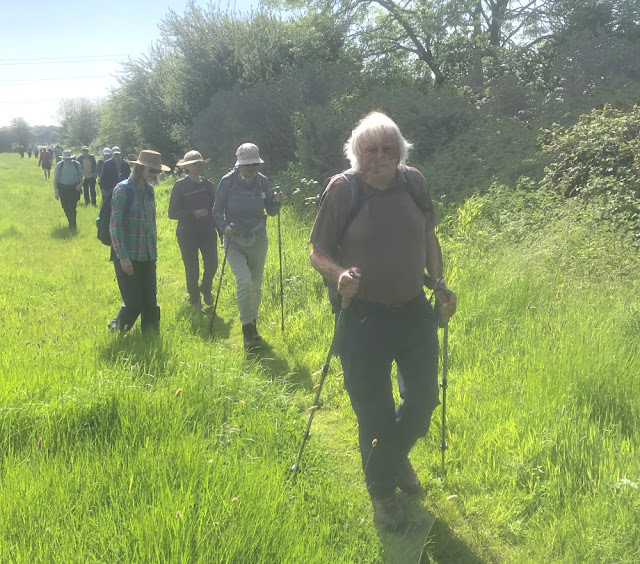Starting at Richard Arkwrights Cromford Mill, Sunday's 10½ mile route took us past Scarthin Books before taking a sharp turn off the road and up through woods high up along the side of the Derwent Valley and then stopping for a welcome break at the Heights of Abraham. Another climb and descent took us to St James' Church in Bonsall for coffee before a drop down Bonsall Dale to the Via Gellia and the mill of the same name. Yet another climb through meadows of flowers took us to Tor Lane and Middleton for lunch.
From Middleton, it was a short distance to Middleton Top and the High Peak Trail, the starting point for this walk in 2017. Two steep descents took us down the Trail to High Peak Junction on the Cromford Canal from where it was a gentle stroll along the Canal back to the start.
 |
| Cromford Mill is the world's first water-powered cotton spinning mill, developed by Richard Arkwright in 1771. The mill structure, classified as a Grade I listed building, is a UNESCO World Heritage Site |
 |
| The location of the original water mill is shown here |
 |
| The Arkwright Society has secured a total of £330k from Severn Trent Water and Derbyshire County Council to install a 20kW hydro-turbine to power the buildings |
 |
| Scarthin Books, number 6 bookshop in the World according to the Guardian. Unfortunately, it could fall down under the weight of its 100,000 books |
 |
| Footbridge over road to Heights of Abraham - time for a breather |
 |
| Heights of Abraham cable cars |
 |
| Distant view over Matlock Bath of Riber Castle and High Tor, route of the Derwent Valley Heritage Trail |
 |
| Another Peak and Northern Footpaths Society signpost |
 |
| St James the Apostle's Church, Bonsall ... |
 |
| ... and yet another coffee stop |
 |
| Japanese Garden in Bonsall Dale |
 |
| Via Gellia Mill at the bottom of Bonsall Dale, built in the late 18th century by Richard Arkwright |
 |
Next to the Mill Pond, a source of water for both the Via Gellia Mill and mills in Cromford
|
 |
| Looking back at Middleton from Middleton Moor |
 |
| Dropping down from Middleton Moor to the Engine House at Middleton Top on the High Peak Trail. Plenty of flowers at this time of year including cowslips |
 |
| The High Peak Railway line first opened in 1831 and was mainly designed to carry minerals and goods between Cromford Canal and the Peak Forest Canal. Following the closure of the line, the Peak District National turned it into a trail for walkers and cyclists. It runs for 17 miles from Dowlow near Buxton to High Peak Junction on the Cromford Canal |
 |
| Group in front of the boilers of the Engine House containing the winding engine from the once busy Cromford and High Peak Railway |
 |
| Examining the winding gear below the trail |
 |
| Another incline - one of many on the High Peak Trail |
 |
| Distant view from the High Peak Trail of Arkwright's Willersley Castle |
 |
| The Catch Pit, designed to stop runaway waggons before they reached the High Peak Junction and Cromford Canal |
 |
| Approaching High Peak Junction |
 |
| "The world's oldest surviving railway workshop" |
 |
| Our route back over the swing bridge on the canal |
 |
| Wheatcroft Wharf Cafe - nearing the end at Cromford Wharf |
 |
| Off route - fine waterwheel in Cromford |
 |
| 10½ miles, 660m of ascent - more than Ben Nevis this weekend |






































































